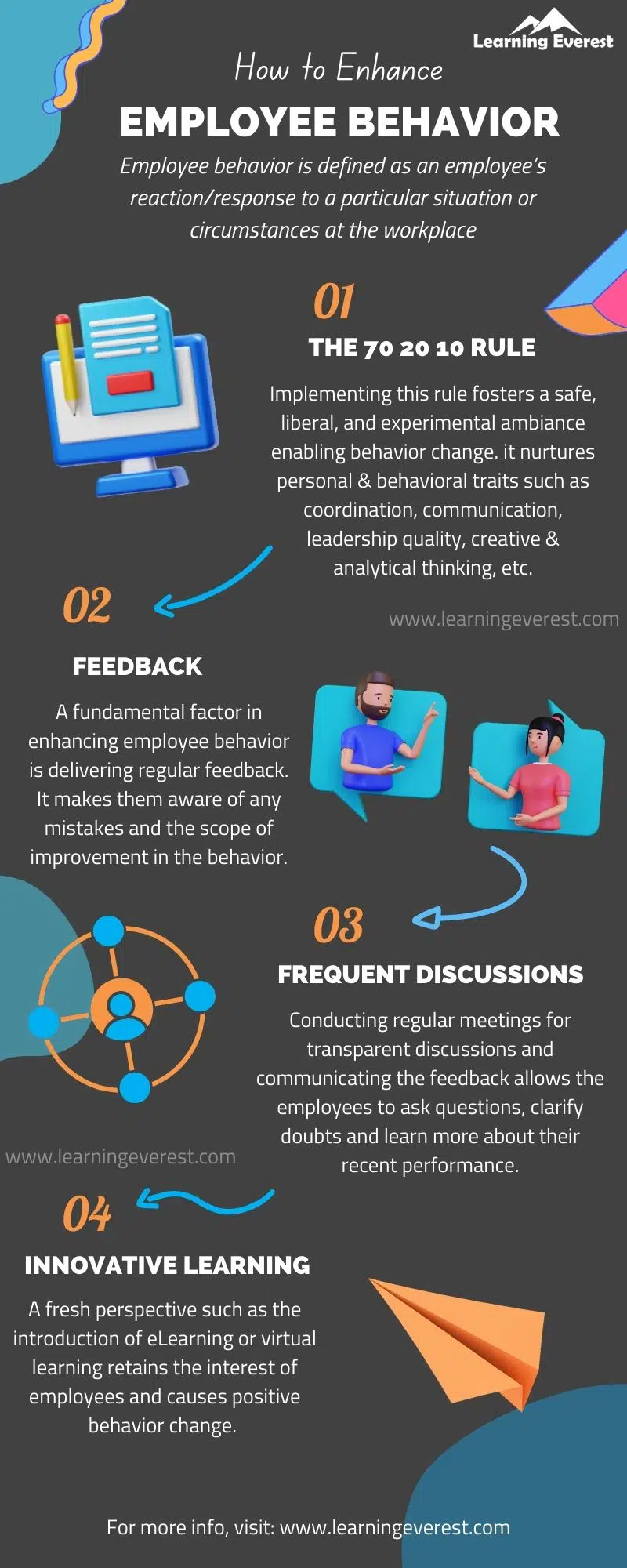Employee behavior at the workplace is one of the predominant factors in deciding business growth, organizational values & ethics while achieving short-term and long-term objectives. Here, the need for training plays a pivotal role in sculpting desirable employee behavior. However, changing behavior is not an overnight process and requires drilling beyond the surface to determine the elements influencing it. This article puts the spotlight on the meaning behind employee behavior, the factors responsible for it, and the ways to drive change.
Table of Contents
- What is Employee Behavior?
- Some Examples of Employee Behavior
- What makes Employee Behavior change necessary?
- Factors influencing Employee Behavior
- Ways to Transform Employee Behavior
- Conclusion
- Infographics
- Frequently Asked Questions (FAQs)
- What are the types of employee behavior?
- What are workplace behaviors examples?
- What is good employee behavior?
- What are the common counterproductive behaviors of employees?
What is Employee Behavior?
Employee behavior is defined as an employee’s reaction/response to a particular situation or circumstances at the workplace. It varies from person to person and is inherently determined by their respective culture, beliefs, and personal experiences. For instance, Optimism, respect, adaptability, teamwork, accountability, etc., are some of the desirable and critical behaviors of effective employees. In other words, ethics, morals, and responsibility are the three pillars affecting employee behavior.
Some Examples of Employee Behavior
A few examples of practical employee behavior are:
- A polite and humble tone of speech
- Respect towards the co-workers, especially female counterparts
- Practicing discretion towards the organization’s information and strategies
- Honest and accountable behavior towards the actions
And so on… There are numerous examples of adhering to a company’s guidelines, ethics and demonstrating exemplary employee behavior to steer business metrics and tactics. However, the main categories that make up all other sets of behavioral conduct are:
- Employee productivity
- Regular work attendance
- Organizational citizenship behavior – comprising of all the positive actions
- Counterproductive work behavior – refers to behaviors that might harm an organization’s reputation or the people working there
- Job satisfaction
What makes Employee Behavior change necessary?
Employee behavior is the driving force behind a business’s success. The everyday actions of employees add up to play an integral role in achieving the organizational vision & mission. For example, it is essential to produce successful results from the training of employees on the core business processes and policies. Disciplined behavior ensures a positive approach and outlook on the training sessions conducted by the organization and, therefore, leads to profitable results.
Without enhancing the behavior, learning and development of the employees serve no purpose and become worthless.
Factors influencing Employee Behavior
Employees are a valuable asset to an organization to deliver paramount quality services. Their behavior is conditioned by a mix of internal and external factors. Employers and managers must be aware of these factors and drive them in their favor to accomplish the business goals and objectives. Let us go through them:
Positive work environment
A cheerful environment is undoubtedly the foremost internal factor governing employee behavior. Organizations with a close-knit, inclusive, and diverse internal culture based on mutual respect likely cause employee retention and productivity increase. Moreover, a positive environment results from impeccable leadership and harmonious relations.
Leadership
Leaders serve a vital role in deciding the behavior, more than what you think. The employees look upon their leaders and managers as a source of inspiration in terms of being productive and adhering to the rules & regulations of the organization. Additionally, the leaders are responsible for setting a direction and rendering constant guidance for day-to-day tasks through multi-mode communication. They also play a crucial role in concreting values of inclusion, respect, and support for each other across.
On the other hand, if the boss or managers are strict, employees tend to sway away from their work and develop a disliking towards it. Therefore, the leaders need to establish a performance and behavior attitude benchmark.
Harmonious work relations
A welcoming, equal, transparent, and cooperative environment proves to be an attraction for the employees. The enforcement of positive values at the workplace fosters efficacious relations and a drastic change in employee behavior. As a result, employees feel valued, included, and they enjoy their work and yield productive results.
Job responsibilities
Another factor determining employee behavior is job responsibility. It is never a good idea to overburden the employees with the workload, as it will eventually cause exhaustion and the work quality would drop. Moreover, it could possibly result in feeling frustrated and angry by being stuck with the work. An integral part of an employee’s job responsibilities is tackling customer demands and driving satisfaction. Let us have a more detailed look into how customers shape employee behavior.
Customer Demands
Customer expectations and demands are the external force recognized to pressure employees. It motivates them to perform better to align the deliverables with the changing demands and awareness. But at the same time, it disturbs the mental and physical capacity of the employees with elevated expectations from the behavior.
Personal life
The most important external factor affecting employee behavior is personal life problems. Family or personal issues lead to stressful and irritating behavior traits causing a negative impact on the work. The peace of mind and concentration ability also gets interrupted. In addition, the family background and the employees’ upbringing shape work culture and, in turn, behavior.
Ways to Transform Employee Behavior
To execute behavior change, the employees must be aware of why the difference is a must and how it affects the business operations and processes. Hence, the answer to ‘why’ is indispensable. The employees should be willing to learn new practices and procedures to meet or exceed the business goals.
Some of the key initiatives that help to bring employee behavior change are:
The 70 20 10 rule
70 20 10 rule is the most popular training and development practice across a broad spectrum of industries worldwide. It implies that:-
- 70% of the training is experiential or comes from personal experiences
- 20% of training is through social interactions
- 10% is the formal training delivered by conducting sessions, workshops, and seminars
Implementing this rule fosters a safe, liberal, and experimental ambiance enabling behavior change. It allows the employees to navigate at their own pace, in a self-led manner, to tackle challenges and contribute to decision-making. As a consequence, it nurtures personal & behavioral traits such as coordination, communication, leadership quality, creative & analytical thinking, etc.
Feedback
A fundamental factor in enhancing employee behavior is delivering regular feedback. It makes them aware of any mistakes and the scope of improvement in their behavior. Managers, stakeholders, senior leadership, and teams function as the components of the feedback cycle.
Frequent discussions
Conducting regular meetings for transparent discussions and communicating the feedback allows the employees to ask questions, clarify doubts and learn more about their recent performance. Therefore, leading to the achievement of desired behavior changes.
Innovative learning
Innovative learning and development initiatives could result in improved employee behavior. A fresh perspective such as the introduction of eLearning or virtual learning retains the interest of employees and causes positive behavior change. It includes video or audio-based education, infographics, gamified approach to learning, and more.
Conclusion
Employee behavior is the response to a situation at the workplace, which can be positive or negative. It is steered by external and internal factors such as work environment, job responsibilities, and personal life. Moreover, an individual’s upbringing plays a pivotal role in determining the behavior at the workplace. To foster a productive environment, boost business growth, and establish a dominant footprint in the market with a solid client base, it is essential to enhance employee behavior. It can be achieved through the renowned 70 20 10 rule, feedback, discussions, and innovative training sessions.
Infographics
Frequently Asked Questions (FAQs)
What are the types of employee behavior?
The most important types of employee behavior are:
1. Employee productivity
2. Work attendance
3. Organizational citizenship behavior
4. Counterproductive Work Behavior
5. Job satisfaction
What are workplace behaviors examples?
A few examples of workplace behavior include: maintaining adherence to the organizational values, mutual respect, cooperation, constructive criticism, accountability, adaptability, etc.
What is good employee behavior?
Good employee behavior is a set of positive values and ethics demonstrated by the employee at the workplace. Good employees uplift others around them through constant support, respect, and inclusion. Moreover, they are professional, honest, and cooperative in their conduct.
What are the common counterproductive behaviors of employees?
Counterproductive behavior refers to behaviors that negatively impact the organization or the workforce. They include destroying or stealing a company’s property, faking leaves, insulting other employees, harassing the female counterparts, etc.






